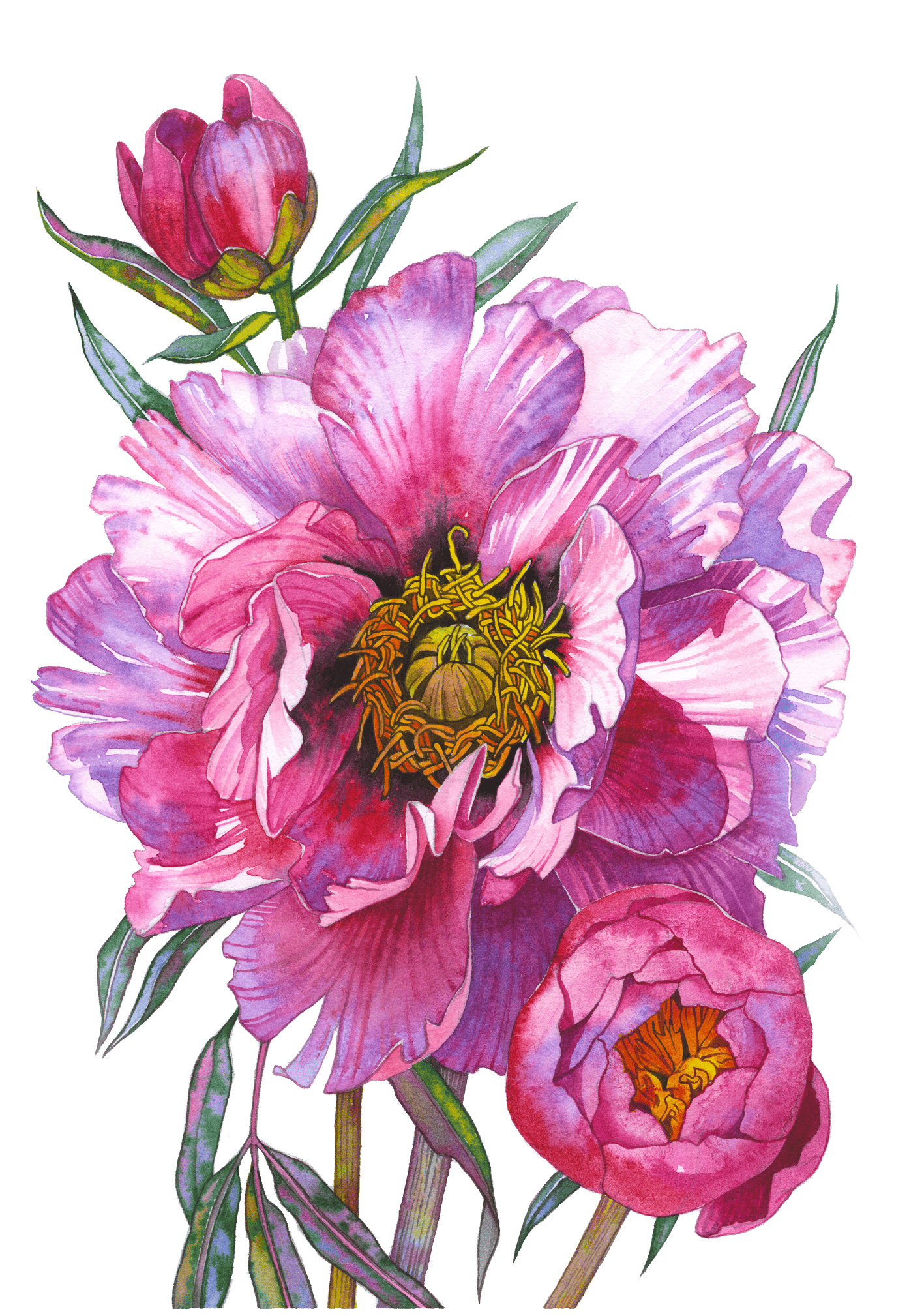«Eustoma Flower»with Margarita Astashova
[BIG] is a format with longer and more detailed paintings.

Material: watercolor
Number of paintings:
1
Duration: 6 hours
Access: lifetime
What will you paint at the marathon

Painting «Flower Eustoma»
At the marathon, you will learn how to:
- build voluminous flowers with many curved petals and core elements;
- achieve broad gradations of purple, introduce subtle color nuances, and realistically depict the natural coloration of the plant;
- recreate relief folds on the petals, their fibrous structure, and pigmentation on plant tissue;
- depict light and shadow on curved surfaces, achieving effects of volume and expressive contrasts.

 Day 1
Day 1
Sketch and First Washes
In this lesson, we will start creating a botanical illustration «Eustoma», make a preparatory painting with a simple pencil, and the first washes with watercolor along with selective detailing.
In this lesson, you will learn how to:
- depict the features of the natural morphology of eustoma, construct voluminous flower forms with many curved petals, and paint complex flower centers;
- achieve a play of shades of purple in tone and temperature in transparent basic washes with watercolor;
- select shades for small details depending on the tonality of the underlying layers;
- paint fine details with a thin brush with soft and sharp edges on wet and dry paint layers to imitate shaded grooves, folds, and pigmentation on plant tissue.

 Day 2
Day 2
Basic Washes and Details
In this session, we will continue to work with watercolor on the multi-layer illustration «Eustoma», performing washes and detailing the petals.
In this lesson, you will learn how to:
- create an imitation of pigment spots with clear edges on the petals when dry;
- paint small shaded folds on the petals on a wet paint layer;
- depict the volumes of flowers and bends of their individual petals through light and shadow work;
- vary the details of the relief in tone and achieve their correct proportion with the underlying layers.

 Day 3
Day 3
Detail Specificity
This session will complete the series of lessons dedicated to the botanical illustration of eustoma. We will enhance contrasts, clarify details on the flowers, and also paint the bud, green leaves, and stems.
In this lesson, you will learn how to:
- selectively strengthen shadows in additional layers, achieve active contrasts in tone, and "sharpen" the effects of volume;
- make washes of flower centers, young buds, stems, and green leaves, as well as their detailing;
- selectively emphasize and sharpen the most significant details;
- introduce an additional stroke layer to imitate plant fibers in the structure of the petals.
Join all three broadcasts to get access to an additional bonus lesson, «Bright Dahlia»
You'll learn:
- recreate the features of the natural morphology of a dahlia, build its overall volume in a turn, and each petal considering the curves;
- show the natural coloring of the plant, mix and match complex shades, and vary them by tone and warmth-coolness;
- work on the small details realistically – folds and creases on the petals, pigment spots, and transparent shadows;
- recreate the tiered structure of the flower in multilayered painting, gradually enhancing the contrasts and saturation of the petals.



The marathon is hosted byMargarita Astashova
- Professional artist and art historian
- Member of the Union of Artists of Russia
- PhD in Philosophy specializing in Aesthetics
- Participant in republican, all-Russian, and international exhibitions
- My artworks are in private collections in homes in Russia, France, and Spain.
Watercolor works by Margarita
Which materials we will use during the marathon
- Watercolor paper 100% cotton, cold press, 300 gsm, A4 size (I use “White Nights” by Nevskaya Palitra; other brands are also suitable) – 4 sheets;
- Watercolor paper 100% cellulose, torchon, 300 gsm, A4 size (I use “PALAZZO” by Lilia Holding; other brands are also suitable) – 1 sheet;
- Round brushes with a fine tip, soft synthetic No. 0, No. 1, No. 2, No. 4 (I use Nevskaya Palitra; other brands are also suitable);
- Round brushes with a fine tip, squirrel imitation No. 3, No. 5 (I use “van Gogh” by Royal Talens; other brands are also suitable);
- Watercolor paints (I use “White Nights” by Nevskaya Palitra, 36 colors; other brands are also suitable);
- Graphite pencil HB;
- Eraser;
- Palette (ceramic or plastic);
- Water container;
- Tissue or cloth for drying brushes;
- Masking tape.

Sign up for the marathon:
Marathon Unlimited
Get +46 marathons with +198 paintings and watch them at your convenience
- Number of marathons: 46
- Number of paintings: 198
- Access: 1 year unlimited
per marathon
Subscribe to Marathon UnlimitedAnnual payment 119.88 $









